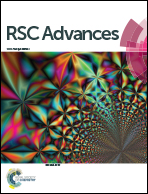Radiosynthesis and evaluation of N-(3,4-dimethylisoxazol-5-yl)piperazine-4-[4-(4-fluorophenyl)thiazol-2-yl]-1-[11C]carboxamide for in vivo positron emission tomography imaging of fatty acid amide hydrolase in brain
Abstract
We developed a novel positron emission tomography (PET) radiotracer N-(3,4-dimethylisoxazol-5-yl)piperazine-4-[4-(4-fluorophenyl)thiazol-2-yl]-1-[11C]carboxamide ([11C]DPFC, [11C]1) for in vivo imaging of fatty acid amide hydrolase (FAAH) in rat brain. Compound 1 showed a high binding affinity for FAAH (IC50: 3.3 nM). [11C]1 was synthesized by reaction of 5-amino-3,4-dimethylisoxazole (2) with [11C]phosgene ([11C]COCl2), followed by reaction with 4-(4-fluorophenyl)-2-(piperazin-1-yl)thiazole (3), with a 9 ± 4% radiochemical yield (decay-corrected, n = 9) based on [11C]CO2. A biodistribution study in mice showed a high uptake of radioactivity in FAAH-rich organs, including the lung, liver, and kidney. PET summation images of rat brains showed high radioactivity (>2 SUV) in the cerebellar nuclei and frontal cortex. This pattern was consistent with the known regional distribution pattern of FAAH in the rodent brain. Pretreatment with the FAAH-selective inhibitor URB597 significantly reduced the whole brain uptake of [11C]1. At 30 min after the radiotracer injection, more than 95% of the total radioactivity was found to be irreversible in the brain homogenate of rats. Our results indicate that [11C]1 is a promising PET tracer for in vivo visualization of FAAH in living brains.
![Graphical abstract: Radiosynthesis and evaluation of N-(3,4-dimethylisoxazol-5-yl)piperazine-4-[4-(4-fluorophenyl)thiazol-2-yl]-1-[11C]carboxamide for in vivo positron emission tomography imaging of fatty acid amide hydrolase in brain](/en/Image/Get?imageInfo.ImageType=GA&imageInfo.ImageIdentifier.ManuscriptID=C5RA22500K&imageInfo.ImageIdentifier.Year=2015)

 Please wait while we load your content...
Please wait while we load your content...